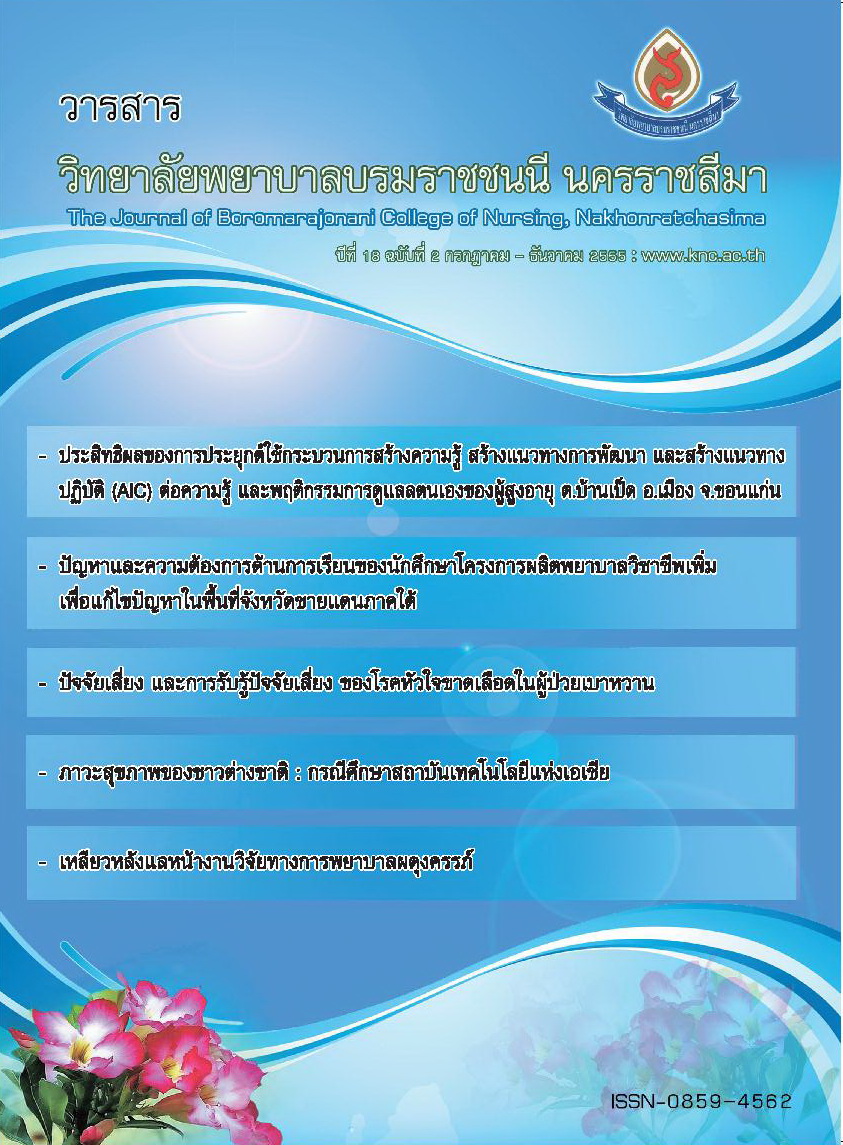ปัจจัยเสี่ยง และการรับรู้ปัจจัยเสี่ยง ของโรคหัวใจขาดเลือดในผู้ป่ายเบาหวาน
คำสำคัญ:
โรคหัวใจขาดเลือด, การรับรู้ปัจจัยเสี่ยง, ผู้ป่วยเบาหวาน, coronary heart disease, perceived risk, diabetes patientsบทคัดย่อ
บทคัดย่อ
โรคหัวใจขาดเลือด เป็นภาวะแทรกซ้อนและสาเหตุการตายที่สำคัญในผู้ป่วยเบาหวาน การศึกษาครั้งนี้ จึงจัดทำขึ้นโดยมีวัตถุประสงค์ เพื่อประเมินระดับปัจจัยเสี่ยง และการรับรู้ปัจจัยเสี่ยงของโรคหัวใจขาดเลือด และปัจจัยที่มีผลต่อการรับรู้ปัจจัยเสี่ยงของโรคหัวใจขาดเลือด ในกลุ่มผู้ป่วยเบาหวาน ชนิดที่ 2 ในตำบลหนองไผ่ จังหวัดอุดรธานี จำนวน 98 คน มีอายุเฉลี่ย 63 ปี ส่วนใหญ่เป็นเพศหญิง (ร้อยละ 79.6) เก็บข้อมูลโดยใช้แบบสอบถาม โดยมีค่าความเชื่อมั่นของแบบสอบถามการรับรู้ปัจจัยเสี่ยง ความรู้เกี่ยวกับปัจจัยเสี่ยงของโรคหัวใจ เท่ากับ .75 และ .85 ตามลำดับ ผลการวิจัย พบว่ากลุ่มตัวอย่างมากกว่าร้อยละ 60 มีระดับการควบคุมโรคเบาหวาน และปัจจัยเสี่ยงของโรคหัวใจขาดเลือดสูงกว่าเกณฑ์ปกติ เช่น HBA1C (69.8%) ความดันโลหิต (62%) ระดับไขมันในเลือด (61.7%) ระดับไตรกลีเซอร์ไรด์ (70.5%) และระดับไขมันที่มีความหนาแน่นต่ำ (81.8%) ค่าเฉลี่ยคะแนนการรับรู้ปัจจัยเเสี่ยงของโรคหัวใจขาดเลือด(M = 7.69, SD = 1.98) และ การรับรู้ภาวะสุขภาพโดยรวมอยู่ในระดับปานกลาง (M = 2.64, SD = 1.03) และการรับรู้ปัจจัยเสี่ยงของโรคหัวใจขาดเลือด มีความสัมพันธ์กับ ความรู้เกี่ยวกับสาเหตุของโรคหัวใจ (r = .359, p < .01) และ การรับรู้สุขภาพโดยทั่วไป (r = -.244, p < .05) ส่วน ความรู้เกี่ยวกับสาเหตุของโรคหัวใจขาดเลือด (β= .385, p < .01) และ การรับรู้สุขภาพทั่วไป (β= -.247, p < .01) สามารถทำนาย การรับรู้ปัจจัยเสี่ยงของโรคหัวใจขาดเลือด ผลการศึกษาครั้งนี้ สามารถนำไปใช้ในการพัฒนารูปแบบการพยาบาลด้านการให้ความรู้และคำแนะนำ เพื่อเพิ่มการตระหนักและการรับรู้ปัจจัยเสี่ยงต่อโรคหัวใจขาดเลือดในผู้ป่วยเบาหวานชนิดที่ 2
คำสำคัญ : โรคหัวใจขาดเลือด, การรับรู้ปัจจัยเสี่ยง, ผู้ป่วยเบาหวาน
ABSTRACT
In Thailand, coronary heart disease is a major complication and leading cause of death among Thai patients with type 2 diabetes. The purpose of this study was to examine coronary heart disease (CHD) risk factors and perception, among people living with type 2 diabetes in Tombon Nongphai, Udon Thani, Thailand. For this cross-sectional study, a convenience sample of people aged 18 years or older (N = 98) was recruited from Tombon Nongphai. The mean age was 63 years old, and 79.6% were female. A self-administered questionnaire was used. The internal consistency reliability coefficient alpha for perception of and risk factors knowledge for heart disease were .75 and .85 respectively. More than half of the participants had uncontrolled glycated hemoglobin (HbA1c; 69.8%), blood pressure (62%), total cholesterol (61.7%), Triglyceride (70.5%), and low-density lipoprotein cholesterol (81.8%). The participants had a medium level perception of heart disease (M = 7.69, SD = 1.98) and self-reported general heath (M = 2.64, SD = 1.03). The perceived risk of heart disease associated with knowledge of coronary heart disease risk factors (r = .359, p < .01) and self-reported general heath (r = -.244, p < .05). In this study, knowledge of coronary heart disease risk factors (β = .385, p < .01) and self-reported general heath (β = -.247, p < .01) significantly influenced the perceived risk of heart disease. In Thai population, these findings could direct nursing personnel to increase the perception of coronary heart disease, among people living with type 2 diabetes who have high risk factors for a heart condition. It is also clear that developing an effective health education program for diabetes patients is needed urgently to reduce risk factors for coronary heart disease.
Keywords : coronary heart disease, perceived risk, diabetes patients
Downloads
ฉบับ
บท
License
บทความที่ได้รับการตีพิมพ์เป็นลิขสิทธิ์ของ วารสารสุขภาพและการศึกษาพยาบาล ซึ่งดำเนินการโดยวิทยาลัยพยาบาลบรมราชชนนี นครราชสีมา
ข้อความที่ปรากฏในบทความในวารสารเล่มนี้เป็นความคิดเห็นส่วนตัวของผู้เขียนแต่ละท่านไม่เกี่ยวข้องกับกองบรรณาธิการวารสารสุขภาพและการศึกษาพยาบาล หรือวิทยาลัยพยาบาลบรมราชชนนี นครราชสีมา แต่อย่างใด ความรับผิดชอบองค์ประกอบทั้งหมดของบทความแต่ละเรื่องเป็นของผู้เขียนแต่ละท่าน หากมีความผิดพลาดใดๆ ผู้เขียนแต่ละท่านจะรับผิดชอบบทความของตนเองแต่ผู้เดียว






